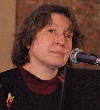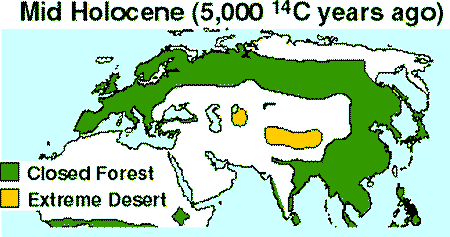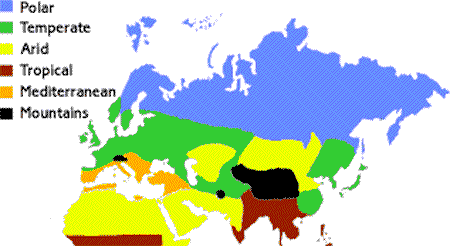
PRA-ALTAIAN WORLD ACCORDING TO COMPARATIVE-HISTORICAL LINGUISTICS
SEMANTIC RECONSTRUCTION (abstract)
(Russian Academy Of Sciences, Linguistics Institute)
Links
Introduction
The work of this type is long overdue. A similar analysis for the Indo-European family was done eons ago, accepted, agreed to, canonized, and then amended uncounted times, as the assumptions were questioned and revised. Considering that for over half a century the Indo-European Kurgan Hypothesis was broiling, with its only contender being a Türkic paradigm, the absence of the Türkic semantic analysis was screaming, a 2003 computer analysis by Russell Gray and Quentin Atkinson for IE languages that challenged the whole IE Kurgan Hypothesis still has not been duplicated for the Altaic linguistic family. Not that all problems will be resolved at once, quite the opposite, a little knowledge would require more knowledge, a shallow depth would require deeper digs. Among the questionable assumptions in this work are the following:
The study assumes a single locality, however large, for the origin of the language and
people. That was not true.
The study assumes a monoethnic origin of the people. That was not true.
The study assumes a tree-like model for the language development. That was not true.
The study assumes a genetic unity of Türkic and far eastern languages, which conflicts
with biological genetic results, and in essence prejudices the origin areal even
before a single word is analyzed.
The study assumes a certain type of cultural etiology (existence of a taboo, for
example). That is unwarranted.
To recite the Dr. Lars Johanson discourse on Altaic languages: Türkic languages are the linguistic family, and neither Mongolian, not Tungus, nor Korean and Japanese belong to it. Any lexical admixture to these languages is from the cultural diffusion only. Using L.Johanson own ringing words, there is a “lack of evidence for a common basic vocabulary in Altaic“. “Look-alikes that occur only in typical contact zones cannot easily be used as evidence for genealogical relatedness.“ In Turkic-Mongolic, “The few pairs of corresponding words do not, however, relate to the most significant parts of the vocabulary“. And “there are hardly any plausible lexical correspondences between Turkic and Tungusic.“ For the remainder, “problems with the Altaic affiliation of Japanese“: “Japanese (with Old Koguryo) and Ryukyuan to form a distinct family of its own“. So analyzing a blend of different language families is like analyzing an egg salad, and concluding that chicken grow in garden furrows. Down goes monocentrism, monoethnicity, Christmas tree model etc.
Putting aside these basic assumptions, and conclusions based on them, the study remains a major step in a right direction.
Posting notes are highlighted in blue.
PRA-ALTAIAN WORLD ACCORDING TO COMPARATIVE-HISTORICAL LINGUISTICS
SEMANTIC RECONSTRUCTION (abstract)
(Russian Academy Of Sciences, Linguistics Institute)
When working with the “encyclopedically loaded“ lexicon, a relevant to the history of language semantic description can be obtained by selecting among semantic features that are structuring the lexical microsystem, a “functional“ and “formal“, or “topographical“ features. Example: two types of names for dwellings. The first (home) carries a functional load, indicating not only “a certain type of structure,“ but also the “locus of the object.“ From that follows a regular polysemy “locus of an object and people associated with it by integral attribution“, “locus of the entity family“ and, as an metonymic substitute (container > content), follows the “family“. Such words are more frequent and demonstrate better the trends in the evolution of semantic lexical microsystems. The names of the second type (hut, tent) indicate only a specific types of buildings, and have no such polysemy. A main problem in the reconstruction of “encyclopedically loaded“ words is a reconstruction of its “topographic“ features, because the functional features are either preserved, or can be traced through the evolution of lexical microsystems, and the topographic names are simply replaced with a changing in the cultural/natural environment, and can be traced only by circumstantial evidence (we can speak of a rectangular type dwelling, if there is a regular polysemantical object of “inside corner“ as a “part of the home“).
The results of the paleoculturally significant sections of the lexicon are as follows.
1. The landscape in the language of pra-Altaians is represented by mountains, in contrast to the high mountains of the pra-Indo-European habitat, by low mountains. In significant number are represented the words for gullies, valleys, and steppes (steppes are absent in the Indo-European lexicon, their mountains are often covered with forest). The pra-Altaian steppes are quite dry and dusty, apparently with low hills. There are many terms for small fast streams with shoals and rapids, but also are words for large rivers (unlike PIE) and floods. For both the PA, and for the PIE, obtaining a reconstruction of a word meaning “sea“ is unsuccessful.
2. The climate of the Altai people ancestral homeland was apparently colder and drier than for the pra-Indo-Europeans. A year (likewise in PIE) was divided into at least four seasons, with cold snowy winters.
| Holocene Forest-Steppe belt | Modern climatic temperature map | |
|---|---|---|
 |
 |
3. Flora allows to suggest that the ancestral home of the Altaians was in the border zone of southern taiga ("taiga" is a name for a regular forest, with author's loaded connotations. you would not call the Ukranian forest a taiga, would you?) and steppe. The list of the reconstructed Indo-European flora gives an impression of a mountain forest somewhere in the temperate zone [Balkans?]).
4. In the PA, and likewise in PIE, is recovered a system of names for wild animals. The differences are significant:
a) In the PA is restored a name of a wild camel, which is not in PIE, but in the PIE are the terms for the wild bulls, which are definitely absent in PA,
b) In the PA is restored a much more detailed sex-age terminology for wild ungulates than in the PIE, which demonstrates the importance of hunting in the life of the pra-Altaians (and is corroborated by the role of undulates in the mythology and art of the Altaians, inclusive of the Siberian "deer" stones, at one time heavily used in the PIE Kurgan hypothesis).
To determine a geographical position for the ancestral homeland of Altaians are important the terms for a wolverine and monkey (the PIE name for the monkey most likely is a Semitic borrowing). While the Indo-European names for large predators retain well the semantics of reflexes, the pra-Altaian names for large predators usually give different reflexes in the daughter subgroups, with fluctuations between bears, wolves and tigers. Probably, that is due to taboos (Actually, probably to the same process that happened in every other society and linguistic group - semantical drift).
5. Hunting and fishing terminology more developed in the PA, which indicates the lesser importance of these classes for the Indo-European economy. The so-called “salmon criteria“ is now recognized as less important to determine the ancestral homeland of the Indo-Europeans (in the proto-language the word could also mean “trout“), but PA is definitely displays a large number of names for the salmon (From the first historical references till present, the Türkic nomads and agriculturists settled in the valleys of the rivers, and that's where archeologists look for their kurgan cemeteries).
6. The core of the pra-Altaian economy appears to be seasonal pastoralism, or a developed seasonal hunting with a corral component. There are terms associated with horses and riding. The role of agriculture was less significant. The main tool was probably a kind of hoe (possibly also used for harvesting wild roots).
For the pra-Indo-Europeans the main type of economic activity were agriculture and well-developed sedentary pastoralism. Apparently, there were specific implements to harnessed plowing. There is a name for hay (absent in the PA), which may indicate a winter livestock housing (as opposed to the change of pastures among the pra-Altaians). In PIE is restored terminology of horse husbandry, but not horse riding. The cattle terminology is more developed in the PIE than in the PA (That agrees with the known ethnological typology, and the role of nomads in the life of the sedentary peoples, including IE agriculturists. To drive herds, and to lead a mobile warfare, you need to be mounted, and that makes a world of a difference between foot walkers and mounted riders).
7. The culinary terminology of both proto-languages does not have significant differences. The ratio of names for milk (including dairy) and meat dishes to the names of the dishes from cereals in both proto-languages is roughly the same. Apparently, bee-keeping was unknown to the pra-Altaians, unlike the pra-Indo-Europeans (This conclusion appears to be selective, since Indo-Iranian IEs were unfamiliar with milk and dairy produce, which in India still lingers until present, and the ancient Greek lexicon indicates Türkic culinary borrowings).
8. In the PA, the terminology of clothing and footwear is more differentiated, for example, it contains the names for pants and kneeguards (which is associated with horse riding), which the PIE does not have (And how you can be a Maria Gambitus' mounted Kurgan invader without pants, kneegards, and boots?).
9. The early stages of metal work, probably bronze, are indicated for both proto-languages? (Due to a cultural dissemination carried by the mounted nomads, the sedentary people on their fringes were introduced to metalworking, independently of its origin)
10. Both PA and PIE have terms associated with spinning and weaving.
11. The nomadic features are better detected in the PA lexicon then in the PIE; the wheel for the PA is not reconstructed, in contrast to the PIE. The PA has more terms related to the boats/rafts (The assertion about wheel is suspicious, the presence of a wheeled transport is as much a pre-condition for nomadic husbandry as seeds are for agriculture).
12. Two types of pra-Altaian home are restored: portable (absent in the PIE) and stationary, both of them can be described in some detail, they are very distinct, and likewise are distinct from the pra-Indo-European housing. The PA does not have a word for a barn (which is present in the PIE), but has a few words for the animal pens. The PA does not have words for clan-based settlements and for the internal structure of the settlements (which are present in the PIE). Like in the PIE, PA has terms for fortified settlements. Unlike for the PIE, the names for the house of the ruler or temple were nor found in the PA lexicon (Having portable housing without a wheel is unrealistic. The absence of "clan-based settlement" lexicon well illustrates the difference between settled settlements, which can't help but be aggregates of various components, vs. mobile settlements that are by definition small and include only the family members. The absence of the terminology for the "house of the ruler" may very well be connected with the assumption of the tree-like model for unrelated languages, which is supposed to weed out lexicon that is not shared by all presumed constituents).
13. The terms of kinship in the PA indicate patrilocality, some of the features indicate a presence of cross-cousin marriage or an exchange of sisters. The terms for co-wives indicate polygamy. The PIE has evidence of patrilocality, but unlikely for cross-cousin marriage. The PIE does not have any words meaning “co-wife“ (patrilocality has little to do with the social organization of society, which for the nomadic husbandry economy indicates strong respect for women and unrestricted participation of women in the life of the society, unknown in the IE agricultural . With the drastic contrast between PA and PIE societies, patrilocality is irrelevant. Another trait that conflicts with the author's findings is cross-cousin marriage, which contravenes a strict exogamy practiced by the nomadic societies, where even the links that ascend for a millennia prevent incestuous conjugal unions until present. The impelled levirate tradition in the nomadic societies naturally has to include the terms for “co-wife“ and associated kinship).
14. Among the property terminology both proto-languages have terms for exchange and trade. A developed system of non-derivative terms of gift giving is reconstructed only in the PA, in the Indo-European languages all names for gifts are derived from the verbs with a meaning “to give“, in addition, (the PA) has terms for winning (in competition), for military and hunting spoils.
15. Of weaponry, in the PA are well restored the terms for several types of arrows and bows, and quivers. The PA has terms for spears and harpoons. The PA does not have specialized terms for the sword (only for the types of knives) (however, akinak/kinğirak/kinirak is rated to be a sword). The PIE does not have common names for the bow and arrows; it has the names for the types of axes, swords and spears (And how you can be a Maria Gambitus' mounted Kurgan invader without bow and arrows?).
16. The religious terminology of the pra-Altaians contains the names of shamans, spirits and shaman ceremonies, it has a root for 'fasting'. That substantially differs from the situation in the PIE, compare a developed pra-Indo-European pantheon (This author's terminology is clearly prejudicial, replace the shaman with priests, spirits with angels, archangels and saints, and shaman ceremonies with religious service, and the underlying phenomena is no different. The question of the development of pra-Indo-European pantheon vs. pra-Altaian pantheon belongs to the same prejudicial sphere).
Conclusions
The collected materials allow restoration of a comprehensive (though somewhat distorted) picture about the paleoculture of the carriers of the pra-Altaian language. The results should be verified by data of paleozoology, paleobotany, historical geography and archeology. Comparison of the received results with the paleoculture pictures for the carriers of the pra-Northern Caucasus and pra-Semitic languages may turn out to be promising.